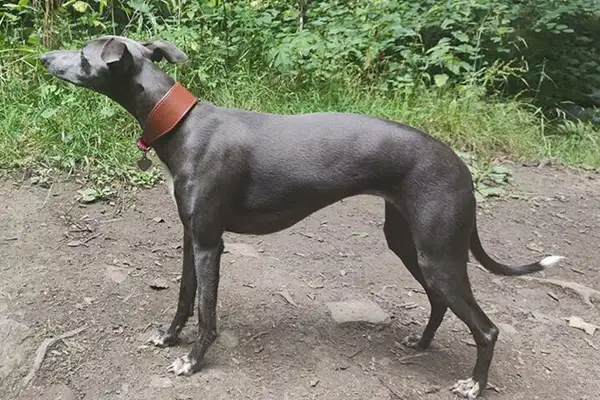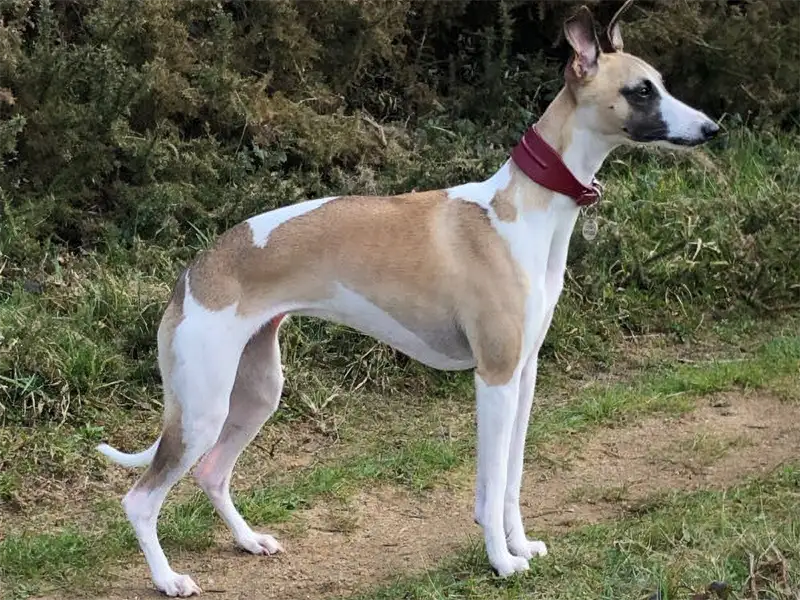Dog Care & Advice
Why Whippets Need Special Collars
If you’ve ever tried to walk a Whippet on a regular dog collar, you’ll know it doesn’t always go smoothly. These graceful, high-speed sighthounds have a unique shape that just doesn’t suit standard pet shop designs. But why exactly do Whippets need special collars — and what makes them different?
Let’s break it down.
Built for Speed, Not for Bulk
Whippets were bred for speed. They have long, slender necks, slim heads, and lightweight bodies built to chase — not to be weighed down. Their necks are often wider than their heads, which means a basic flat collar can easily slip off with just a quick backward step.

That makes a traditional collar a risky option — especially for Whippets with a strong prey drive or a tendency to spook.
Why Narrow Collars Can Be a Problem
Because their necks are so long and delicate, thin collars can create pressure in all the wrong places — particularly around the windpipe. If your Whippet pulls or lunges while wearing a narrow collar, it can cause discomfort or even injury.
That’s why most Whippet collars are wider through the centre, helping to distribute pressure more gently.
The Role of Fishtail and Martingale Collars
Two of the most popular options for Whippets are fishtail collars and martingale collars — both designed to suit their slim build and sensitive necks.
- Fishtail collars are wide through the middle and taper off to a narrow strap at the buckle, protecting the throat while still looking elegant.
- Martingale collars gently tighten when tension is applied but won’t choke or over-tighten, making them ideal for dogs who might slip their collars or need a bit more control.
Can Whippets Wear Harnesses Instead?
Some Whippet owners consider harnesses as an alternative to collars, especially for dogs that pull or have medical conditions affecting their throat. While harnesses can help distribute pressure more evenly across the chest, they don’t offer the same balance of comfort, fit, and style that a well-made Whippet collar does.
Many owners find that harnesses restrict movement or rub awkwardly against their dog’s skin — particularly on slim-framed breeds like Whippets. That’s why even those who use a harness for walks often pair it with a soft leather house collar to hold ID tags and keep things lightweight indoors.
It’s Not Just About Safety — It’s About Comfort
A good collar doesn’t just stop your Whippet from slipping loose — it keeps them comfortable too. Many mass-produced collars use stiff materials, plastic hardware, or sharp stitching that can rub or irritate your dog’s skin.

That’s why all our Whippet collars are handmade using soft Italian leather, stainless steel fittings, and rot-proof stitching — so your dog stays comfortable, walk after walk.
How to Make Sure You’ve Got the Right Fit
Even the best collar won’t help if it’s not sized properly. Whippet collars should sit high on the neck — just behind the ears — and be snug enough to prevent escape, but loose enough not to pinch.
If you’re not sure how to measure correctly, we’ve got a full Whippet collar sizing guide here.
In Summary
Whippets need collars made just for them — collars that account for their unique build, their temperament, and their need for comfort. Whether you prefer the simplicity of a fishtail collar or the added peace of mind that comes with a martingale, choosing the right fit can make every walk a breeze.
Find the perfect collar for your Whippet
Explore More About Whippet Collars:
- Choosing the Right Whippet Collar: A Complete Guide
- Are Martingale Collars Good for Whippets?
- House Collars vs Walking Collars for Whippets
- 5 Common Mistakes When Buying a Whippet Collar
FAQs About Whippet Collars
Why can’t Whippets wear normal dog collars?
Because their necks are usually wider than their heads, flat collars can slip off easily and may cause injury if too narrow.
What kind of collar is best for a Whippet?
A wide fishtail or martingale collar made from soft materials is ideal for both comfort and control.
Do Whippets really need a special collar?
Yes — their slim build and sensitive necks mean they benefit from collars designed specifically for sighthounds.

